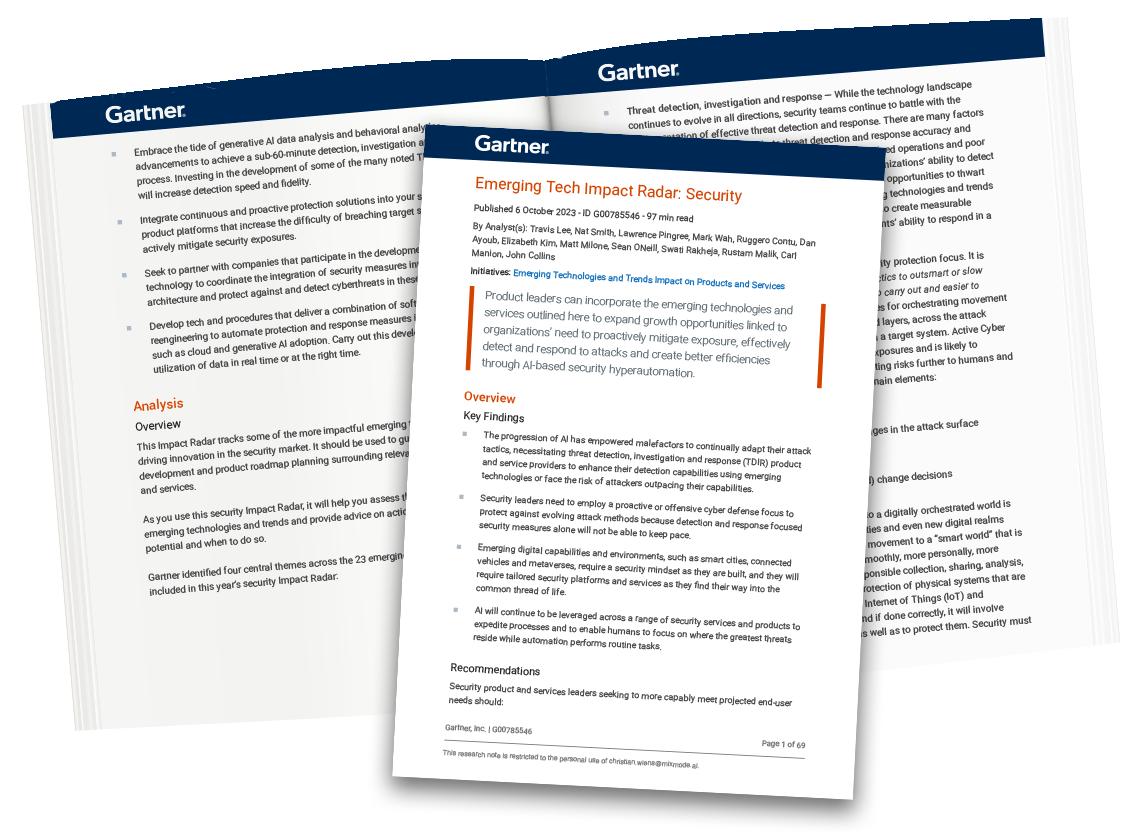Insights and Trends from Gartner Emerging Tech Impact Radar: Security
Gartner recently released their annual Emerging Tech Impact Radar: Security. This report analyzes 23 emerging technologies and trends that will shape the future of cybersecurity products and services. It provides insights to help security leaders develop strategies and roadmaps to capitalize on these innovations.
Four Key Themes
Gartner provided actionable insights that identified four central themes across the technology trends in this year’s report:
- Embrace Threat Detection and Response Advancements
The continued progression of AI is enabling attackers to adapt their methods quickly. Threat detection, investigation, and response (TDIR) products need enhanced detection capabilities to keep pace. Emerging techs like advanced behavioral analytics can improve detection speed and confidence.
- Shift to Proactive Cyber Defense
With evolving attacks, detection and response alone are insufficient. Security teams need proactive defenses that increase attack complexity and mitigate exposures before incidents occur. This entails technologies for continuous protection and active mitigation.
- Secure Emerging Digital Environments
New digital realms like smart cities, connected vehicles, and metaverses require tailored security platforms and services built in from the start. Security leaders should partner with smart world tech providers early on.
- Enable Hyperautomation
AI and automation can optimize security processes and reduce reliance on scarce human resources. The focus is combined software and procedural reengineering using data analytics to drive efficient protection and response.
MixMode Named in the Report
MixMode was highlighted as a key vendor for best-fit providers for AI-Enhanced Security Operations and Advanced Behavioral Detection Analytics but has capabilities for four innovative approaches that leverage AI to enhance detection, automation, efficiency, and overall security capabilities.
AI-Enhanced Security Operations
AI-based security operations refers to using AI and machine learning to automate repetitive tasks in security operations centers (SOCs) and augment human security analysts to make faster decisions. Key capabilities include alert triaging, incident response automation, augmented threat hunting, and guiding analysts.
This is important because AI can help SOCs get more value from limited staff resources by handling routine work and enhancing analysts’ productivity. It also enables keeping pace with increasing volumes of alerts and sophisticated threats.
Advanced Behavioral Detection Analytics
This technology uses machine learning and artificial intelligence to establish normal behavioral baselines for users, devices, and systems. Deviations from expected patterns provide early warning of attacks or insider threats.
Advanced behavioral analytics is crucial for improving threat detection speed and accuracy compared to traditional rules-based methods. Adding behavioral indicators to threat intelligence helps uncover novel attacks that rules would miss.
Identity Threat Detection and Response
ITDR focuses on monitoring identity services, detecting threats targeting identities, investigating incidents, and automating response processes. It provides specialized tools to secure identity infrastructure.
ITDR is important as identities become prime targets for attackers. As organizations adopt decentralized architectures, ITDR will be critical for securing access and privileges. It brings robust protection to identity systems.
Generative Cybersecurity AI
This uses AI models like ChatGPT to generate natural language, automate security workflows, and enhance human capabilities. Use cases include improving detections, guiding analysts, and automating threat hunting.
Generative AI allows security teams to process more data faster and closer to real-time. It also improves user experiences with conversational interactions. As threats advance, AI-enabled defenses will become essential.
These four categories leverage AI to enhance detection, automation, efficiency, and overall security capabilities. Adopting these emerging technologies will be vital for organizations to defend against sophisticated, fast-evolving threats targeting identities, networks, and systems.
The Radar at a Glance

Each profile provides two layers of analysis — a range estimate and a mass estimate. Range — “Range” represents Gartner’s estimate of time to reach early majority (more than 16% target market adoption), not when product leaders should act on investment. Considering the time to plan, develop, and launch, a starter guide to product leader investment timing based on product strategy is as follows:
The four categories mentioned above fall into the Now category, meaning most organizations should look at them and act on ETTs in the Now and 1-to-3-year rings.
Key Technologies and Trends
Here are some additional highlights from the 23 techs analyzed in terms of their expected impact and adoption timeline:
Near Term (1 – 3 years)
- AI-Enhanced Security Operations: Applies AI to automate repetitive tasks and augment human analysts. Will become table stakes.
- Secure Access Service Edge (SASE): Converges network and security into a cloud service. Adoption is accelerating quickly.
- Cloud-Native Application Protection Platforms (CNAPP): Consolidates tools to secure cloud-native apps and resources. Adoption rising.
- Exposure Management: Continuously evaluates assets’ vulnerabilities and attack surface. Driven by explosive growth in exposures.
Mid Term (3 – 6 years)
- Automated Moving Target Defense: Randomizes environments to increase attacker uncertainty and hinder exploits. Prevents vs. detects.
- Policy as Code: Enables infrastructure-as-code tools to implement security controls and policies. DevSecOps accelerator.
- Software Supply Chain Security: Protects all stages of software dev lifecycle. Demand increased after high-profile open-source breaches.
- Machine Identity Management: Secures and controls identities for workloads and devices. Critical as cyber-physical systems grow.
Long Term (6 – 8 years)
- Quantum-Enhanced Security: Leverages quantum tech for encryption, communications, and machine learning. Revolutionizes cryptography.
- Cybersecurity Mesh Architecture: Interoperable security services to enable dynamic, adaptive access control and threat response.
- Security in the Metaverse: Decentralized identity, access management, and threat monitoring tailored to immersive virtual worlds.
Key Takeaways
Gartner forecasts significant developments using AI to enhance threat detection, speed investigation and response, and enable cybersecurity automation. Proactive security capabilities will grow in importance. Architectures will shift to support zero trust, cloud-native apps, and new digital environments. Quantum technologies will bring advancements.

Security leaders should proactively evaluate these trends and time investments to capitalize on those that align with their risk profile, attack surface, and business priorities. Partnering with emerging technology providers is a crucial way to prepare for the future of cybersecurity.
Click Here to Download the Full Report


.png)